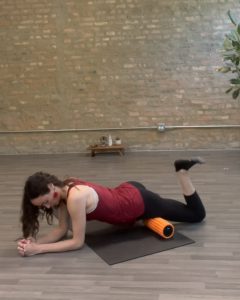What to do between Therapeutic Massage Appointments:

First, take a moment to think about why you get massages.
If you like to get massages to help increase or maintain range of motion: keep moving and try foam rolling. The phrase “motion is lotion” is accurate when it comes to easeful movement. Movement increases blood flow to muscle tissue as does massage. Similarly, rolling on a foam roller or tennis or lacrosse balls in a way that is pain free can also help move fluid around in your tissue. Think of your tissue like a dried out sponge that alternately gets dipped into water, then squeezed out, then dipped back in etc etc. This is akin to what a compressive massage and a foam roller does to the fluid in your tissue. If you are working an area like the front of your thighs or quads, you can be particularly efficient by also bending and straightening your knee while you are leaning into the roller and then working your way from the hip to the knee end of your thigh. Think: “Compress, bend/straighten knee, move an inch to the next spot, repeat.”
If you seek out massage for relaxation, try to recreate the state of calm you experience during or after your massage by practicing daily breathing exercises. They can be simple and short. Get into a comfortable position, try to breathe slowly through your nose and, if possible, slow down your exhalations the most.
If you come to massage for pain management, follow the same breathing instructions as above. A large part of managing pain is staying out of a chronic fight or flight state. (And learning to recognize when you are in an anxious state so you can pause.) Breathing slowly is the easiest way for you to influence your nervous system. It is the one “tool” that is always available to you and that you have control over. Slow exhales tend to be especially relaxing for most people. Try to breathe in towards the bottom of your pelvis and out towards your throat with your spine long and neutral (vs very flexed or very extended). Try to keep your shoulder still vs letting them lift up towards your ears when you inhale. Instead, let your abdomen and ribcage expand in all directions (vs just forward and up) and find a rhythm and breath length that is longer than your day to day breathing but not so long that it stresses you out. Another strategy you can try is gargling or humming. While this may sound strange, those actions require activation of nerves that tend to also stimulate the rest and digest branch of your nervous system.
Book your massage

vurcazkircazpatliycaz.NQhvUx0Cytk6
vurucuteamgeldi.NcgAlKmub0Ie
daktilogibigibi.GoKsPeWmKVg1
daxktilogibigibi.VhHNTL37auoe
I’ve read several just right stuff here. Certainly price bookmarking for revisiting. I wonder how a lot effort you place to create this kind of great informative website.
My brother suggested I might like this blog. He was totally right. This post actually made my day. You can not imagine simply how much time I had spent for this info! Thanks!
xyandanxvurulmus.G4iT2SzOo0cR
xbunedirloooo.KDIDyfGd8NFC
neuroanatomies xyandanxvurulmus.okJxePI2TL2u
Thank you for the good writeup It in fact was a amusement account it Look advanced to far added agreeable from you However how could we communicate
ghessed xyandanxvurulmus.9OWAwQ8IA0ps
best allergy medications over the counter allergy pills for adults does benadryl make you sweat
Thank you for the auspicious writeup. It in fact was a amusement account it. Look advanced to far added agreeable from you! However, how can we communicate?
sleep medication prescription online buy melatonin 3mg pills
I do not even know how I ended up here but I thought this post was great I do not know who you are but certainly youre going to a famous blogger if you are not already Cheers
cost deltasone buy prednisone 10mg online
painkiller for stomach pain perindopril buy online
cause of pimples in adults order cefdinir 300mg online cheap low cost prescription acne medication
alphabetical list of allergy medications zaditor 1mg uk allergy pills without antihistamine
gastric tablet name list buy lamivudine generic
isotretinoin 20mg cheap brand accutane 10mg accutane 40mg cost
bahis siteleri porn vurgunyedim.PyFDjfqu4fQG
online sleep prescriptions buy modafinil pills
craft porn yaralandinmieycan.f8ptulPmQ1Xe
order amoxil 500mg online cheap cheap amoxicillin 1000mg order amoxicillin without prescription
strong sleep pills phenergan canada
azithromycin generic azithromycin brand azithromycin 250mg oral
neurontin 600mg uk order gabapentin 800mg for sale
childrens sex citixx.vqUgaRi27bDS
sektor benim zaten amin evladi hyuqgzhqt.I6XmSCLCbMda
porno izle ewrjghsdfaa.15dJxDxz1HWB
sexx wrtgdfgdfgdqq.waookEIOuLbn
bahis siteleri porn sex incest wrtgdfgdfgdqq.22aNN3cWDrzd
porno siteleri wrtgdfgdfgdqq.6qToTWH6OaSY
sexax wrtgdfgdfgdqq.kc6OiUAUq1QW
azithromycin where to buy azithromycin 500mg cheap buy azipro pills for sale
buy furosemide diuretic buy lasix paypal
prednisolone 20mg generic omnacortil 40mg pills how to get prednisolone without a prescription
allsaintsbeirut.com
Fang Jifan은 스스로 일을 할 수 있기 때문에 당연히 신경 쓰지 않습니다.
https://www.lib.nkust.edu.tw/portal/global_outurl.php?now_url=http%3A%2F%2Fvantaihoaituong.com%2F
amoxicillin 250mg canada amoxicillin 500mg oral buy amoxil 1000mg pills
buy monodox pill doxycycline 100mg generic